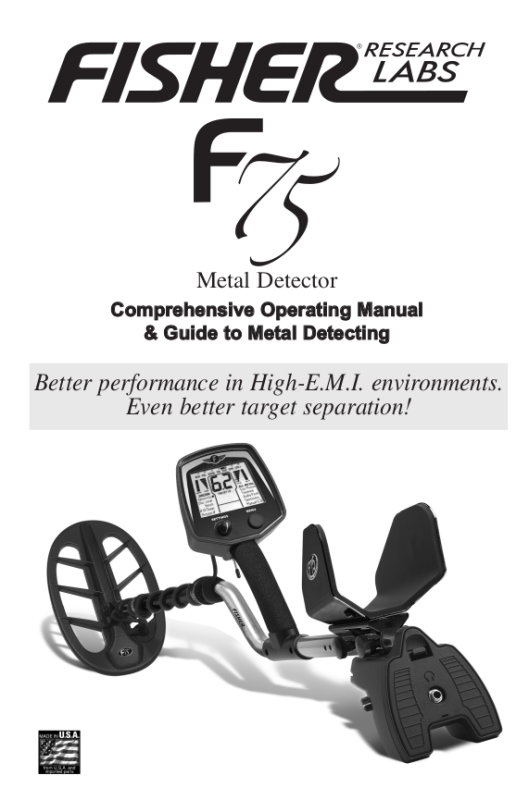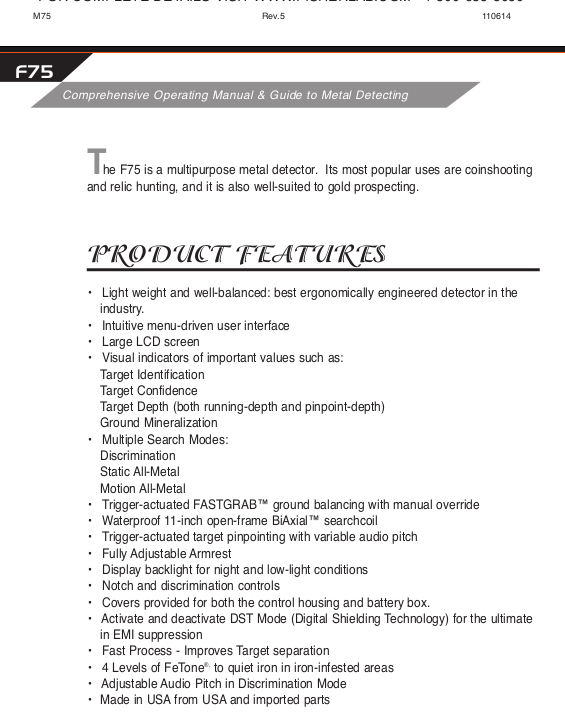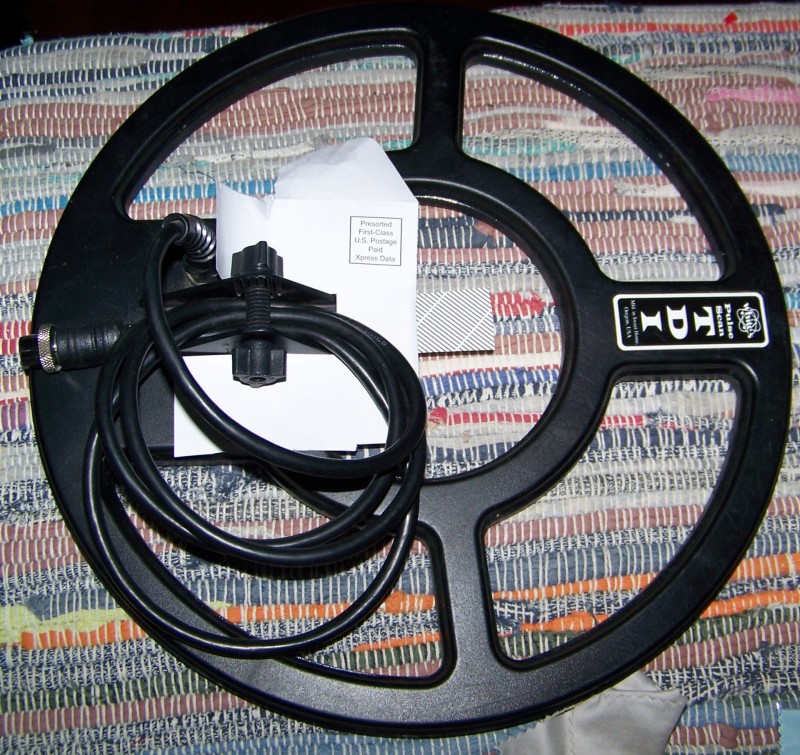-
Posts
5,790 -
Joined
-
Last visited
-
Days Won
12
Content Type
Forums
Detector Prospector Home
Detector Database
Downloads
Everything posted by GB_Amateur
-
I do:
-

F75 V. T2 All Metal Modes
GB_Amateur replied to abcoin's topic in First Texas - Bounty Hunter, Fisher & Teknetics
Yep, and there are the various later models (F70, F75+, Teknetics Patriot) which included some but not all of their so-called 'processes'. Pretty much the same detector, just varied features (and prices). -

F75 V. T2 All Metal Modes
GB_Amateur replied to abcoin's topic in First Texas - Bounty Hunter, Fisher & Teknetics
Just a small addition: I think all the F75 models have static all metal. I do find their nomenclature confusing: 'Limited', 'Ltd', 'Special Edition', 'SE', etc. Here's the manual for the regular (gold shaft) model after Digital Shielding Technology (DST) was added, but in addition I have a pre-DST manual for the gold model and it also shows static all metal: -
You just named three items I've yet to find, too. In fact I haven't gotten any thimbles, regardless of the material makeup, and my only halves are clad. You must have a good spot there, and unless it's on the beach or a location soon to be developed, it'll still be there waiting for you after the storm passes. Maybe some more firsts still there!
-
The Fisher Gold Bug Pro (twin sister of the F19) has a special place in my memory (and detector closet) since it re-introduced me to detecting in 2015 after ~35 year hiatus. Last weekend my neighbor saw me coming back from a 'hunt' and asked me to find his property line stake. He showed me its approximate location which was close to both a metal light pole and metal utility box cover. Out comes the Fisher F75 with tiny 4"x6" concentric coil -- the right tool for the job. I quickly located two screamer hits, one being the desired target. First Texas gets a lot of negative criticism here, some of it justified and other just sharks in a feeding frenzy after seeing blood in the water. As others (e.g. El Nino77 recently) have noted, we can be thankful for some great products they've produced over the years that are still getting the job done. Your F19 is certainly one of those.
-
Excellent story to accompany your nice finds. Coincidentally I've visited your grandfather's hometown 2 or 3 times for meetings and tests at the Columbia Scientific Balloon Facility. I recall it can get quite uncomfortable (as in hot+humid) in the summer months. I see why you want to get out now before that starts!
-
I think the 'John' who was part of this interview is John Gardiner, another First Texas Engineer. Unfortunately Steve H. mentioned in another thread that First Texas's new website no longer includes several informative articles, etc. I'm pretty sure this was from one of those although you didn't indicate where you found it.
-
Local libraries are good repositories of historical info and librarians tend to be very helpful. And don't be surprised to find there were old newspapers even in small towns -- much bigger deal than today. Sometimes small towns had more than one! Libraries will have those on microfiche or maybe even on CD/DVD.
-
Not quite sure what you are asking, but here are some info (in some cases with numbers) that may help. 1) According to the scientific work that the article was based upon, they're referring to something that happened *very* early in the earth's history. To put this in relative terms, compare the earth's age with a human who lives 90 years. Right now the earth is middle aged -- equivalently about 45 years old. This meteorite bombardment occurred when the earth was (equiv.) 0.2 years (a few months) old. Needless to say the place was a lot different then! (The work referred to was done with 3.8 billion year old rocks from Greenland -- some of the oldest rocks on earth. The human equivalent age of the earth for those -- 7 years old.) 2) The mass of those meteorites is estimated at 2x10^19 (think 2 followed by 19 zeros) tons or 2x10^22 kg. The mass of today's earth is 6x10^24 kg, so this meteorite bombardment is about 1 part in 300 of the earth's current mass. (BTW, you can think of mass as weight -- true at the earth's surface anyway.) 3) Meteorite compositions have a ballpark (there's a range but this number is good for getting our heads around it) mass ratio for Fe to Au of 1 million (1x10^6). For the average earth's surface (crust) composition is about four times that high, so meteorites on average are a bit more concentrated in gold than other rocks/dirt/etc, but not ridiculously so. People have speculated regarding mining asteroids. IMO those stories tend to be exaggerated. But here is a decent article on the subject. Basically, though, they're still talking about ppm of precious metals, it's just that some asteroids are (relative to earth's mines) large and you can pick the ones that are primarily metals. I.e. you don't need to clear overburden and get rid of all the worthless silicon, oxygen etc. -- the early solar system already did that for you. The earth was formed from the solar nebula. So were the sun, the other planets, natural satellites (aka 'moons') the asteroids, and comets. The nascent sun had enough mass to collect the dominant elements: hydrogen in particular, plus helium) while the planets' lower masses let those go and mostly kept the heavy stuff. So no magic here, at least no more than has been known for quite a while. Precious metals are rare and even when concentrated (e.g. nuggets) that's still the case.
-
AFAIC all we have are rumors at this point. A short response to a social media question -- is that the way of the world now? Detecting season in the Northern Hemisphere is fast approaching. Similar to houses on the market, for the general detecting population (not necessarily the zealots here 😏), there's a sweet-zone in the calendar for people gearing up for summer recreation and we're pretty much on it with Spring popping up now. (But there's always Christmas. 🤔) Other marketing 'examples' of new detector announcements might have influenced Garrett. Do they go the XP and Algoforce route, keeping quiet until they have models ready for sale, or Minelab and Nokta with teaser ads, etc. a few to several months before release? They did the latter for the AT/Max, and I think for the Apex. Wasn't the Axiom announcement fairly close to production?
-

Axiom Coil Bolt Update - Now Available Online
GB_Amateur replied to CarsonChris's topic in Garrett Metal Detectors
Here's another possible option which works in the field if you can just get to a hardware store: Top photo shows the factory White's bolt and nut. Bottom is a toilet seat bolt and nut -- 3/8-16 plastic (nylon) size. Note: some toilet seats use a larger 7/16 diameter bolt. (I don't know what the standard is in the rest of the world, but wouldn't be surprised if a similar solution exists with metric sizes.) You can see in the second photo that the White's coil bracket hole is just slightly undersized such that the non-threaded shank of the toilet seat bolt won't quite fit. You could file or sand down the bolt pretty easily, and at least for the White's coils the 2 1/2 inch length leaves plenty of room to add the nut even if you don't go that extra step. As to whether this works for the Axiom, IDK, but you could take the coil to the hardware store to find out. Cost is ballpark $1.00 to $1.50 if I remember correctly. They should have 3/8 plastic washers, too. Here's an example of a pair from Menards (midwest big box lumber/hardware store similar to Lowes and Home Depot): -
As someone who has done all three: 1) Gold clubs (GPAA being one, but where you live I suspect there are local/regional versions as well) are good in that they provide places to detect (claim access) as part of their membership. Getting advice on how to use a detector, though, while possible from the right person (such as Kevin Hoagland of GPAA) is not always that easy. Oh, you'll get plenty of people who think they know what they are doing, both in this regard and reading the land, etc. Cost: $50 to $100 per year (ballpark) which in the case of GPAA includes a subscription to the bi-monthly Gold Prospector magazine. 2) Getting face-to-face instruction from an experienced person (such as Gerry and his crew) has a lot to be said for it. Not only will they get you off on the right track but give you the confidence that you are going about it the right way. And since the classes are (in Gerry's case anyway) taught in a location where gold has been found you have a good chance of finding your first nugget. (I did.) Cost: several hundred dollars but can be discounted if you buy a detector from the teacher. 3) Books such as Chris Ralph's Fists Full of Gold are also helpful, particularly when you get to the point where you want to find promising spots on your own, but also when you are on a claim and want to find the spots to give you the best chance of finding gold. Cost: $30 (for Chris's book, and that puts you in the ballpark for others as well). Bottom line is that 1) and 3) are of quite reasonable expense and 2) is worth it, IMO, to get you off and running. You mention you aren't in a hurry, so you can probably get away without personal instruction, but I tried that for half a dozen trips West before I took Gerry's class. I don't regret paying for any of the three as I think they are worth it to me personally (I've been a GPAA member for 10 years now) but if given a do-over I wouldn't have waited so long to get the personal instruction.
-

Thank You Minelab For The Manticore
GB_Amateur replied to Jeff McClendon's topic in Minelab Manticore Forum
Excellent report, Jeff. Gives other Manticore owners (myself included) a lot of hope/confidence. But more than just the detector and the sites I've got to think that the detectorist has a big part in this. I have yet to find such masked targets as you are getting and I have hunted some parks with it that likely have a lot in common with yours (other than high mineralization which makes some of yours even tougher). Thanks for posting your settings. I'm confused with what "iron bias 0" means for the Manticore, though. -

Sometimes Previously Hunted Sites Open Up
GB_Amateur replied to GB_Amateur's topic in Metal Detecting For Coins & Relics
My experience is similar, and yes, they did mint a lot (2.8 billion from two mints, each over 1 billion). That's about six times as many as any previous year and still a record. It wasn't until 35 years later that the billion mark was again exceeded by a single mint. I think it relates to the change from silver to clad (although the 5 cent composition didn't change). Congress was slow to make a decision so the mint kept putting out 1964 dated coins until well into 1965. Bowers also mentioned hoarding of coins in general, related to the popularity of the new Kennedy half dollar. Seems strange but he knows his stuff. Yes, that's a common find in school yards as well as parks. I guess they brought them out in their pockets for recess, and then... They don't always read as clean (TID-wise) as the typical nickel, but they are close enough for those of us who don't want to miss any of the 5-cent coins, especially the older ones (Buffies and V-s) which can read a tad low sometimes. -
I've been slow out of the gates for the 3rd year in a row, but hopefully I can follow through better than recently. I do have some ideas for sites I haven't hunted (and if I'm real lucky, no one else has either). But that needs to wait for summer. In the meantime.... A site that has produced modestly (Wheaties and a few silver dimes) in the past has a previously closed area that's opened up. I was able to get out last weekend and give the Manticore a chance. Here's what I found in 3 hours: The highlight is the four silvers, the best of those being the nearly uncirculated 1953-D Roosie. It's a very common date+mintmark but a bonus is that it's from my birth year. Wish I looked that good after 70 years. Maybe being buried in the ground is an advantage! 😁 (On second thought, I'll find out about that soon enough....) The denomination breakdown is interesting but may not be terribly meaningful: three 1-centers (two are Wheaties), nine 5-centers ('nickels), three dimes but two are silver (I'll take that ratio!), no 25-centers at all. Only three of the nickels have dates later than 1964. Has this area ever been searched? And how long has it been 'uninhabited'? Or did someone hunt it decades ago but ignored nickels, not wanting to dig beavertails? Note I found more nickels than imposters (five folded-over beavertails, a couple pencil ferrules, and a misc. scrap of aluminum). The shotgun butt (next to the padlock) is very likely from quite long ago given this area has been settled for longer than I've been alive. The small item left of the padlock is a piece of junk jewelry, probably a broken off pierced earpiece (plated copper with a blue glass 'stone'). I didn't photograph all the trash targets, but that's 2/3 to 3/4 of them. Surprisingly the two Warnicks (1943-P and 1943-S) show the gray patina that is representative of that population which have circulated but never been in the ground. Usually the acid in the soil eats off that surface, leaving the white metal (silver) finish. For one of the two I didn't even realize what it was until I got home and cleaned off the dirt. Only one coin was even close to being challenging -- the Roosie was 7 1/2 inches deep. I picked up a faint but clean signal with the Manticore 11" coil (All Terrain High Conductor mode). While investigating I turned up the sensitivity from 17 to 21, then backed off to 19 for the rest of the hunt. It definitely sounded louder at the higher sensitivity settings. (In my test garden it seems going much higher than 18 smears out the VDI resolution, getting worse the higher the sensitivity. That's why I've been using 17.) Anyway, I'm not done there so hopefully I can show more goodies in the near future. Quantity of hunts has been low but quality of finds the opposite!
-

Cheers From Metal Detecting Couple From Southern Europe!
GB_Amateur replied to Heavy Metal's topic in Meet & Greet
Welcome, Heavy Metal! I don't watch many videos, but this site is all about sharing experiences and knowledge with like-minded detectorists. You should feel comfortable here as many share your passion and your interest in history. -
Ah, there's half of that economics lesson -- Supply and Demand. Apparently that also carries over to concentric coils. When was the last time a high(er) end IB/VLF even had a concentric option? I'm thinking it was something from Nokta, but even that has been quite a while (as in more than 5 years), I'm guessing. Is it really the case that a DD (of the proper size) has all the advantages of a concentric? That didn't used to be the claim by many detectorists, but maybe they voted with their wallets in the end and thus we're where we are in 2024.... Or is it a physics/engineering issue, that Multifrequency and Concentric are incompatible? (That doesn't let them off the hook, though, given that MF released models have single frequency option already built in.)
-
I've been investigating a technique for a while now and it seems to work pretty well for me so I decided to put it out here for others to try, if they so choose. It's something I took advantage of with the Eqx 800, but there only for discriminating shallow USA nickels vs. shallow aluminum trash. My new method with the Manticore has a broader appeal. Specifically I use this for coin detecting but it may also work for other intended targets, particularly relics. I'll just describe it first and at the end give you my settings, which may just be specific to my soils but may also be key to the effect -- IDK. My default hunt mode is All Terrain, High Conductors (AT-HC). When I get a high conductivity hit (70 or above, where most USA copper and silver coins live), I then change the mode to All Terrain General (AT-G). This is easy to do by setting one of the two upper front panel buttons, aka 'soft keys' (I choose the left one) to be 'Favorite'. I have AT-HC set as my favorite and AT-G as default search mode, but it really doesn't matter which is set to which since pressing the Favorite button just toggles between the two. What I've found is that if the AT-HC digital TID (dTID) is the same or close to the AT-G dTID, the target ID is reliable -- i.e. a high conductor. OTOH, if the AT-G dTID is well below the AT-HC dTID (10-15 units is typical), it's likely some kind of unwanted trash (e.g. a roofing nail or bolt). Now for my settings for both modes: 'All metal' (no notching, etc.), recovery speed = 4, Ferrous Limits 8/3, Stabilizer = 0. I was running sensitivity = 17 initially but have recently upped that to 19. And, yes, I Ground Balance and Noise Cancel at the start of a session, which typically remains steady for the rest of the hunt. The following are very unlikely to affect the method described above, but for completeness: I have Ferrous Tones set to a low volume (I think it's 3), Normal Audio Theme, Medium Audio Profile, Custom 5 tones, with breaks to enhance USA coin ID's, each tone having a flat (constant) pitch.
-
So almost half a Troy Ounce (~14/31) at 6 inch depth?
-

New Tv Series - America's Backyard Gold With Dave Turin
GB_Amateur replied to phrunt's topic in Detector Prospector Forum
I saw an ML Gold Monster and what I think was a GPX 5000. (Surely you recognized whatever it was.) Also he gave away a Royal cleanup device. I suspect both ML and Royal have contributed -- it should show up in the credits, I think, if that's the case. The problem I have with the show is that it seems to be exaggerating what can be done. (And you're correct there. If the audience falls for this it's going to sell quite a bit of equipment.) "$3 trillion in gold still available (in the USA alone)"?????? 30 minutes of sniping leads to several hundred dollars worth of gold? Even if some have the sites, knowledge, stamina, etc. to accomplish that, claiming the general public can do so?? Give me a break. That middle aged+ couple in Siskiyou County California (borders on Oregon) sluicing in the Klamath River for (maybe) $1000/wk, both working 7 days/week and probably 10-14 hour days -- divides out to less than $10/hr per person. That's more realistic, IMO. Then he says "that's over $50,000/yr", (assuming, of course, they can do this every week of the year). How realistic is that? -
@phrunt I stand corrected, it says 'Manticore' right there in the illustration's title. In that case I'll agree with Cudamark, maybe then some. 30 on the Equinox 600/800 is where the USA 25c ('quarter') hits. On the Manticore it's more like 87, not 82 as in the cartoon. 82 in fact is where our 10c (dime) comes in on the M-core, at least some of them (maybe only the silver ones with the clad version a couple units lower). In their defense it's possible on some settings (different search modes and/or different frequencies) or even on particular targets the Eqx 800 TID of 30 does line up with the Manticore 82 TID. I go by the All Terrain High Conductor scale in multifrequency. Tough crowd here? OK, sometimes I resemble that remark.
-
Assuming it's magnetite, isn't this analogous to saying "oh, I got bit by a poisonous snake, but just some swelling, pain, high fever, and vomiting,... not ridiculous"? When you were swinging while no targets were under the coil there appeared 02 and 03 on the screen. What does that mean? And has anyone figured out, concluded, been told whether the TID in pinpoint mode is or isn't from a true IB process, making this a hybrid detector? Thanks for the vid and report. Snow before the Autumnal Equinox? Sounds like the northern part of our North American continent! I've experienced snow (flurries) on 1st Sept. in Northern Manitoba, and I was headed (far) South the next day!
-
That's usually a bad assumption. 😏 There's almost always at least one person who will find value in an observation. And already (as I post) seven have. You must have a sophisticated piece of software (maybe it's your brain?) to come up with that fit curve. A small suggestion: if you could also plot this with the two scales (horizontal and vertical) being the same, i.e. 5 notches on the horizontal scale taking up the same distance as 5 notches on the vertical scale, it might be a bit more revealing (or not...). Regardless, I think this shows that where the slope is steeper the Manticore (in theory) has better resolution, relative to the Equinox, than where the slope is shallow. But to be fair (to the Equinox?), that's a relative conclusion. I think it takes a different study to conclude that an absolute resolution advantage exists. The ML Marketing 'cartoon' claimed this when it showed two nearby (artificial?) targets being split into two different TID's on the 900 while both showed the same TID on the 800. BTW, wasn't the Minelab Marketing illustration strictly for the 800 vs 900, with the Manticore unmentioned? If so maybe it's risky to compare your plot (specifically Equinox 800 vs. Manticore) with the Marketing illustration. (I say that as much for myself as anyone, since I've kind of mixed up the two, at least in my head).







